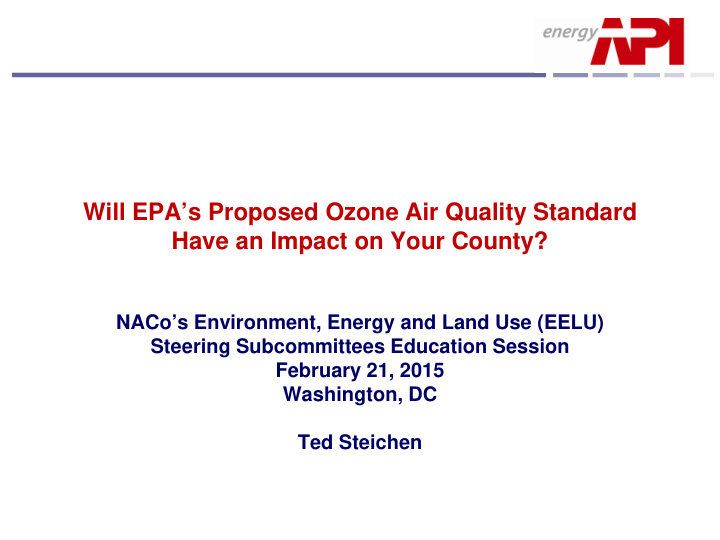



Will EPA’s Proposed Ozone Air Quality Standard Have an Impact on Your County? NACo’s Environment, Energy and Land Use (EELU) Steering Subcommittees Education Session February 21, 2015 Washington, DC Ted Steichen
Are you impacted Now? 2008 8-hr Ozone Nonattainment Areas Source: EPA Green Book
http://www.epa.gov/groundlevelozone/maps.html
Yet Standard EPA Non-Attainment Determinations applied to the same 2025 projections tells a different story… At 70 > Not 9 - but 57 counties with more than 46,000,000 people (OUTSIDE CALIFORNIA) At 65 > Not 59 more – but more than 240 total counties
Comment Period Still Open – Please Weigh In November 26 Proposed Rule Signed December 17 Proposed Rule Published in Federal Register January 29 & February 2 Public Hearings Washington, DC; Arlington, TX; Sacramento, CA 90-day public comment period closes March 17 July? EPA Option Selection OMB Review August – September Final Rule Signed October 1
Comments 1. Don’t impose unnecessary regulation. • The U.S. government has a responsibility to keep federal regulations sensible and not change standards on businesses and consumers needlessly. 2. Give state and local governments a chance to meet the most recent standards before changing them again. • Despite having spent billions of dollars on reducing air pollution, several metropolitan areas are having a very tough time meeting the current standards. The EPA should focus on helping these communities meet the old standards before placing new standards.
Comments (cont’d.) 3. Don’t set standards that can’t be achieved because of background ozone levels. • There are many areas of the country where the naturally occurring level of ozone is above what the EPA is considering, so it is not right to hold a county or state to a standard that is impossible to reach. 4. Don’t set standards that threaten America’s competitiveness and American jobs. • Tightening ozone standards could increase costs to the American public, reduce America's ability to compete internationally, and threaten American jobs. • The recent study by NERA Economic Consulting found that a stricter ozone regulation could reduce U.S. GDP by $270 billion per year and $3.4 trillion from 2017 to 2040 and result in 2.9 million fewer jobs or job equivalents per year on average through 2040.
Comments (cont’d.) 5. Air quality progress will continue under existing regulations. • The nation's air quality has improved over the past several years, and ozone emissions will continue to decline without new regulations. 6. Health data show the current standards are protective. • These new standards are not justified from a health perspective because the science is simply not showing a need to reduce ozone levels.
What are the NAAQS? National Ambient Air Quality Standards (NAAQS) set by EPA as mandated by the Clean Air Act Primary standards – set to protect public health, • including “sensitive populations” (children, elderly) Secondary standards – set to protect the • environment Set for six “criteria” air pollutants: particulate matter, ozone, nitrogen dioxide, sulfur dioxide, lead, carbon monoxide Scientific evidence reviewed every five years Ozone standard is under review, current primary level expressed as 0.075 ppm or 75 ppb
Comment #6 (detail) Health data show the current standards are protective. These new standards are not justified from a health perspective because the science is simply not showing a need to reduce ozone levels. Two key health issues Lung function impacts • Mortality from long-term ozone exposure •
Comment #4 (detail) Don’t set standards that threaten America’s competitiveness and American jobs. Tightening ozone standards could increase costs to the • American public, reduce America's ability to compete internationally, and threaten American jobs. The recent study by NERA Economic Consulting found • that a stricter ozone regulation could reduce U.S. GDP by $270 billion per year and $3.4 trillion from 2017 to 2040 and result in 2.9 million fewer jobs or job equivalents per year on average through 2040.
40% @ 65 ppb
Comment #4 (continued) Developing a State Implementation Plan or “SIP”
Overview of CAA Ozone Planning & Control Mandates by Classification NSR offset Major ratio source threshold TRAFFI C CONTROLS DURI NG CONGESTI ON 1.5 : 1 10 CLEAN FUELS REQUI REMENT FOR Extreme BOI LERS PENALTY FEE PROGRAM FOR MAJOR SOURCES 1.3 : 1 25 Severe LOW VOC REFORMULATED GAS VMT GROW TH OFFSET; VMT DEMONSTRATI ON ( & TCMs I F NEEDED) 1.2 : 1 50 Serious NSR REQUI REMENTS. FOR EXI STI NG SOURCE MODS ENHANCED I / M CLEAN FUELS PROGRAM ( I F APPLI CABLE) MODELED DEMO OF ATTAI NMENT MI LESTONE CONTI NGENCY MEASURES FOR RFP 1 8 % RFP OVER 6 YEARS ENHANCED MONI TORI NG PLAN STAGE I I GASOLI NE VAPOR RECOVERY 1.15 : 1 100 Moderate BASI C I / M CONTI NGENCY MEASURES FOR FAI LURE TO ATTAI N 1 5 % RFP OVER 6 YEARS MAJOR SOURCE VOC/ NOx RACT ATTAI NMENT DEMONSTRATI ON TRANSPORTATI ON CONFORMI TY DEMONSTRATI ON 1.1 : 1 100 Marginal NEW SOURCE REVI EW PROGRAM MAJOR SOURCE EMI SSI ON STATEMENTS BASELI NE EMI SSI ON I NVENTORY ( EI ) PERI ODI C EMI SSI ON I NVENTORY UPDATES 21
As a result of failure to submit a SIP or implement a • SIP. Within 18 months of a finding one of two offsets can • be imposed; the second within 2 years. A ratio of at least 2:1 emissions reductions within the • nonattainment area for new or modified major facilities undergoing NSR. Highway funding sanctions. FHWA is required to • impose funding moratorium for all but exempt projects (safety, mass transit). Detail on EPA presentation available at: •
More Information http://www.slideshare.net/Environmental-Initiative/aburano-lessons-for-why-to-avoid-nonattainment-and-how-minnesota-might-do-it
More Information http://www.api.org/policy-and-issues/policy-items/environment/economic-impacts-of-ozone-regulations
Recommend
More recommend